William Shakespeare
Список книг автора William ShakespeareThe Collected Works of William Shakespeare
This comprehensive eBook presents the complete works or all the significant works – the Œuvre – of this famous and brilliant writer in one ebook – 8460 pages easy-to-read and easy-to-navigate: • The Complete Works of William Shakespeare • Hamlet, Prince of Denmark • The Tragedy of Romeo and Juliet • Macbeth • Hamlet • Shakespearean TragedyA. C. Bradley • Beautiful Stories from Shakespeare and E. Nesbit • Othello • The Tempest • Romeo and Juliet • A Midsummer Night's Dream • The Tragedy of King Lear • The Tragedy of Julius Caesar • Shakespeare's Sonnets • The Merchant of Venice • The Taming of the Shrew • The Tragedy of Macbeth • A Midsummer Night's Dream • As You Like It • A Life of Sir Sidney Lee • Tales from ShakespeareCharles Lamb and Mary Lamb • King Richard III • Twelfth Night; Or, What You Will • Shakespeare's Tragedy of Romeo and Juliet • The Tempest • Much Ado about Nothing • Hamlet, Prince of Denmark • Henry V • Julius Caesar • What Is Man? and Other Essays • Representative Men: Seven LecturesRalph Waldo Emerson • Hamlet • Much Ado about Nothing • Notes to Shakespeare, Volume III: The TragediesSamuel Johnson • Shakespeare's Comedy of The Tempest • Antony and Cleopatra • Tales from ShakespeareCharles Lamb and Mary Lamb • The Tempest • The Winter's Tale • Measure for Measure • King Lear • Romeo and Juliet • Venus and Adonis • Othello, the Moor of Venice • The Tragedy of Coriolanus • The Comedy of Errors • King Lear • The New Hudson Shakespeare: Julius Cæsar • The Rape of Lucrece • The Merchant of Venice • The Tragedy of Titus Andronicus • Twelfth Night; Or, What You Will • Tales from ShakespeareCharles Lamb and Mary Lamb • The Dark Lady of the SonnetsBernard Shaw • The Sonnets • Macbeth • etc.
The 30-Minute Shakespeare Anthology
Drawing on his eighteen years of experience as a teaching artist for Folger Shakespeare Library, Nick Newlin offers eighteen scenes to get young actors on their feet performing Shakespeare with confidence, understanding, and fun!Each scene averages five minutes in length, containing two to six characters, and features a monologue that young performers can use in performance, audition, or competition. Every scene has been «road tested» by one of Newlin's student groups at the Folger's annual Secondary School Shakespeare Festival, and includes dynamic stage directions and incisive performance notes to help teachers and students bring Shakespeare's plays to life. The 30-Minute Shakespeare Anthology includes one scene and monologue from eighteen of Shakespeare's greatest plays, including Romeo and Juliet , Macbeth , Hamlet , Othello , A Midsummer Night's Dream , Julius Caesar , Much Ado About Nothing , As You Like It , The Merchant of Venice , and The Taming of the Shrew .Additionally, the anthology contains a scene and monologue from Henry IV Part I , King Lear , As You Like It , The Comedy of Errors , The Tempest , Twelfth Night , The Merry Wives of Windsor , and Love's Labor's Lost .Also featured is an essay by editor Nick Newlin on how to produce a Shakespeare play with novice actors, and notes about the original production of this abridgment at the Folger Shakespeare Library's annual Student Shakespeare Festival. Each scene and monologue has accompanying notes and performance suggestions.
Julius Caesar: The 30-Minute Shakespeare
Nick Newlin has broad experience marketing the Nicolo Whimsey Show to high school and library systems, and will incorporate The Thirty Minute Shakespeare into the Nicolo Whimsey website, mailings, school fairs, etc. We have purchased and successfully used theater mailing lists from MDR in the past, and will purchase new MDR lists aimed at the target users of The Thirty Minute Shakespeare for the initial launch, and annually or biannually thereafter. We expect that the abridgements will also be prominently cited by the Folger Shakespeare Library’s very active Folger Education program, recognized and used extensively by thousands of high school and college educators and including blogs, webinars, lesson plans, and conferences.There are other «cuttings» of Shakespeare plays, but the only series with any trade visibility is «Sixty Minute Shakespeare» by Cass Foster, with six plays published by Five Star Publications. Nick Newlin's «Thirty Minute Shakespeare» series is publishing 12 plays in 2010, all «road tested» at the Folger's annual Student Shakespeare Festival, and superior to the competition on many levels: better stage directions and performance notes, more professional page design, a competitive pricing structure, and better visibility in Bowker, Amazon, key wholesalers, etc.
Romeo and Juliet (Wisehouse Classics Edition)
Romeo and Juliet is a tragedy written by William Shakespeare early in his career about two young star-crossed lovers whose deaths ultimately reconcile their feuding families. It was among Shakespeare's most popular plays during his lifetime and along with Hamlet, is one of his most frequently performed plays. Today, the title characters are regarded as archetypal young lovers. Romeo and Juliet belongs to a tradition of tragic romances stretching back to antiquity. The plot is based on an Italian tale translated into verse as The Tragical History of Romeus and Juliet by Arthur Brooke in 1562 and retold in prose in Palace of Pleasure by William Painter in 1567. Shakespeare borrowed heavily from both but expanded the plot by developing a number of supporting characters, particularly Mercutio and Paris. Believed to have been written between 1591 and 1595, the play was first published in a quarto version in 1597. The text of the first quarto version was of poor quality, however, and later editions corrected the text to conform more closely with Shakespeare's original. Shakespeare's use of his poetic dramatic structure (especially effects such as switching between comedy and tragedy to heighten tension, his expansion of minor characters, and his use of sub-plots to embellish the story) has been praised as an early sign of his dramatic skill. The play ascribes different poetic forms to different characters, sometimes changing the form as the character develops. Romeo, for example, grows more adept at the sonnet over the course of the play.
The Sonnets of William Shakespeare (Wisehouse Classics Edition)
SHAKESPEARE'S SONNETS is the title of a collection of 154 sonnets by William Shakespeare, which covers themes such as the passage of time, love, beauty and mortality. The first 126 sonnets are addressed to a young man; the last 28 to a woman. The sonnets were first published in a 1609 quarto with the full stylized title: “SHAKE-SPEARES SONNETS. Never before Imprinted.” (although sonnets 138 and 144 had previously been published in the 1599 miscellany The Passionate Pilgrim). The quarto ends with “A Lover's Complaint”, a narrative poem of 47 seven-line stanzas written in rhyme royal—though some scholars have argued convincingly against Shakespeare’s authorship of the poem. The sonnets to the young man express overwhelming, obsessional love. The main issue of debate has always been whether it remained platonic or became physical. The first 17 poems, traditionally called the procreation sonnets, are addressed to the young man urging him to marry and have children in order to immortalize his beauty by passing it to the next generation. Other sonnets express the speaker's love for the young man; brood upon loneliness, death, and the transience of life; seem to criticize the young man for preferring a rival poet; express ambiguous feelings for the speaker's mistress; and pun on the poet's name. The final two sonnets are allegorical treatments of Greek epigrams referring to the “little love-god” Cupid.
Hamlet - Prince of Denmark (Wisehouse Classics Edition)
The Tragedy of Hamlet, Prince of Denmark , often shortened to Hamlet, is a tragedy written by William Shakespeare at an uncertain date between 1599 and 1602. Set in Denmark, the play dramatises the revenge Prince Hamlet is called to wreak upon his uncle, Claudius, by the ghost of Hamlet’s father, King Hamlet. Claudius had murdered his own brother and seized the throne, also marrying his deceased brother's widow. Hamlet is Shakespeare’s longest play, and is considered among the most powerful and influential works of world literature, with a story capable of “seemingly endless retelling and adaptation by others.” The play likely was one of Shakespeare’s most popular works during his lifetime, and still ranks among his most performed, topping the performance list of the Royal Shakespeare Company and its predecessors in Stratford-upon-Avon since 1879. It has inspired many other writers—from Johann Wolfgang von Goethe and Charles Dickens to James Joyce and Iris Murdoch—and has been described as «the world's most filmed story after Cinderella». The story of Shakespeare’s Hamlet was derived from the legend of Amleth, preserved by 13th-century chronicler Saxo Grammaticus in his Gesta Danorum, as subsequently retold by 16th-century scholar François de Belleforest. Shakespeare may also have drawn on an earlier (hypothetical) Elizabethan play known today as the Ur-Hamlet, though some scholars believe he himself wrote the Ur-Hamlet, later revising it to create the version of Hamlet we now have. He almost certainly wrote his version of the title role for his fellow actor, Richard Burbage, the leading tragedian of Shakespeare’s time. In the 400 years since its inception, the role has been performed by numerous highly acclaimed actors in each successive century.
The Complete Works of William Shakespeare
From Shakespeare’s historical plays and comedies such as As You Like It and The Taming of the Shrew, to the great tragedies of Macbeth, Othello and Hamlet you will find the famous plots, wit and drama. This volume is a reprint of the Hayes Barton titles published for the educational market. Included are his Sonnets and longer poems.









